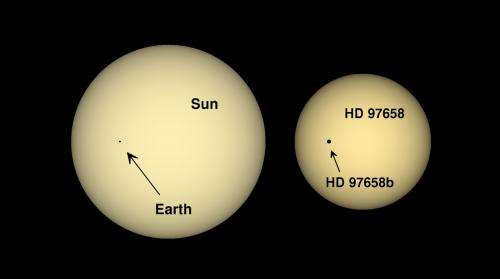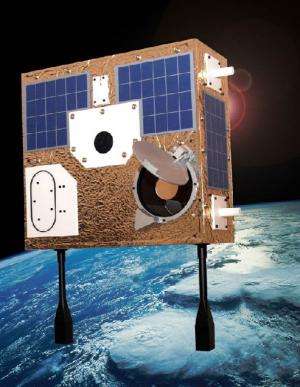Astronomer uncovers the hidden identity of an exoplanet

(Phys.org) —Hovering about 70 light-years from Earth –– that's "next door" by astronomical standards –– is a star astronomers call HD 97658, which is almost bright enough to see with the naked eye. But the real "star" is the planet HD 97658b, not much more than twice the Earth's diameter and a little less than eight times its mass. HD 97658b is a super-Earth, a class of planet for which there is no example in our home solar system.
While the discovery of this particular exoplanet is not new, determining its true size and mass is, thanks to Diana Dragomir, a postdoctoral astronomer with UC Santa Barbara's Las Cumbres Observatory Global Telescope (LCOGT). As part of her research, Dragomir looked for transits of this exoplanet with Canada's Microvariability & Oscillations of Stars (MOST) space telescope. The telescope was launched in 2003 to a pole-over-pole orbit about 510 miles high. Dragomir analyzed the data using code written by LCOGT postdoctoral fellow Jason Eastman. The results were published online today in the Astrophysical Journal Letters.
A super-Earth is an exoplanet with a mass and radius between those of the Earth and Neptune. Don't be fooled by the moniker though. Super-Earth refers to the planet's mass and does not imply similar temperature, composition, or environment to Earth. The brightness of HD 97658 means astronomers can study this star and planet in ways not possible for most of the exoplanet systems that have been discovered around fainter stars.
HD 97658b was discovered in 2011 by a team of astronomers using the Keck Observatory and a technique sometimes called Doppler wobble. But only a lower limit could be set on the planet's mass, and nothing was known about its size.

Transits, such as those observed by Dragomir, occur when a planet's orbit carries it in front of its parent star and reduces the amount of light we see from the star ever so slightly. Dips in brightness happen every orbit, if the orbit happens to be almost exactly aligned with our line of sight from Earth. For a planet not much bigger than our Earth around a star almost as big as our Sun, the dip in light is tiny but detectable by the ultraprecise MOST space telescope.
The first report of transits in the HD 97658 system in 2011 turned out to be a false alarm. That might have been the end of the story, but Dragomir knew that the ephemeris of the planet's orbit (a timetable to predict when the planet might pass in front of the star) was not exact. She convinced the MOST team to widen the search parameters, and during the last possible observing window for this star last year, the data showed tantalizing signs of a transit –– tantalizing, but not certain beyond doubt. A year later, MOST revisited HD 97658 and found clear evidence of the planet's transits, allowing Dragomir and the MOST team to estimate the planet's true size and mass for the first time.
"Measuring an exoplanet's size and mass leads to a determination of its density, which in turn allows astronomers to say something about its composition," Dragomir said. "Measuring the properties of super-Earths in particular tells us whether they are mainly rocky, water-rich, mini gas giants, or something entirely different."
The average density of HD 97658b is about four grams per cubic centimeter, a third of the density of lead but denser than most rocks. Astronomers see great significance in that value –– about 70 percent of the average density of Earth –– since the surface gravity of HD 97658b could hold onto a thick atmosphere. But there's unlikely to be alien life breathing those gases. The planet orbits its sun every 9.5 days, at a distance a dozen times closer than we are from our Sun, which is too close to be in the Habitable Zone, nicknamed The Goldilocks Zone. The Goldilocks nickname is apropos: If a planet is too close to its star, it's too hot; if it's too far away, it's too cold, but if it's in the zone, it's "just right" for liquid water oceans, one condition that was necessary for life here on Earth.
Over the past few years, systems with massive planets at very small orbital radii have proved to be quite common despite being generally unexpected. The current number of confirmed exoplanets exceeds 600, with the vast majority having been discovered by radial velocity surveys. These are severely biased toward the detection of systems with massive planets (roughly the mass of Jupiter) in small orbits. Bucking that trend is HD 97658b, which orbits its star at a distance farther than many of the currently known exoplanets. HD 97658b is only the second super-Earth known to transit a very bright star.
"This discovery adds to the still small sample of transiting super-Earths around bright stars," said Dragomir. "In addition, it has a longer period than many known transiting exoplanets around bright stars, including 55 Cnc e, the only other super-Earth in this category. The longer period means it is cooler than many closer-in exoplanets, so studying HD 97658b's properties is part of the progression toward understanding what exoplanets in the habitable zone might be like."
More information: Paper: dx.doi.org/10.1088/2041-8205/772/1/L2
Journal information: Astrophysical Journal Letters
Provided by University of California - Santa Barbara





















